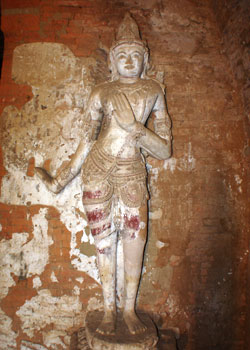The Nagayon Temple is located in the southern part of Myinkaba. In the south of Myinkaba. Nagayon. was built at the end of the 11th century by Kyansitthar. according to the plan of Ananda; even roof. same terraces. very stupas. even Sikkhara. Of Môn style. it resembles the Indian temples of the area of Orissa.


Structure
A portico in the north. paved with green glazed stones and having niches holding stone reliefs of the Buddha. provides access to the Nagayon. Within the temple itself. the central shrine contains a huge standing image of the Buddha. Two smaller images flank the main one. A corridor. also paved with green glazed stones. runs around the central shrine. Dim light comes in through the perforated windows of the outer walls. The walls of the corridor have niches holding stone sculptures depicting the Buddhas previous to Gotama. as well as paintings showing scenes from the Jatakas and the Final Life of Gotama Buddha.
One penetrates by the principal entry which is located at North in a rather dark hall. The déambulatoire even is enlightened for him only by 5 windows with stucturées openings and limiting itself to some rays of light. The déambulatoire is equipped with many niches where were images of Buddhas – alas empty the majority today.


Inside the temple
In fact of the niches for the 27 Buddhas which preceded the historical Buddha Gautama. the 28. Paintings which decorate the déambulatoire are of different invoice feed most beautiful are characteristic of the period of Kyansitthar. Inside the temple. the main Buddha image is twice life size and shelters under the hood of a huge naga. or serpent. The outer. dark corridor has many niches with images of the earlier Buddhas. Paintings also decorate the corridor walls. The central shrine has two smaller standing Buddhas as well as the large one. The small ruined stupa of Pawdawmu Paya is located nearby.
Nearby Attractions
ABEYADANAR
This Pagoda built by King Kyanzittha in adoration for his wife contains a seated brick Buddha that has now been mostly covered concrete. However the true attraction lies in the stunning paintings that cover the inner walls. most representing images from Mahayana Buddhism. such as Brahma. Indra and Vishnu.
SOEMINGYI MONASTERY
The monasteries where built both with brick and wood. but it is only the brick monasteries-called kalakyaung or “Indian monasteries” – which have survived. Square in plan. it has a vestibule on the eastern side and a double-storeyed sanctum on the western side. There is a central hall. with cells ranged along its northern and southern sides. A staircase in the southeastern corner leads to roof. which was of wood and probably flat.

